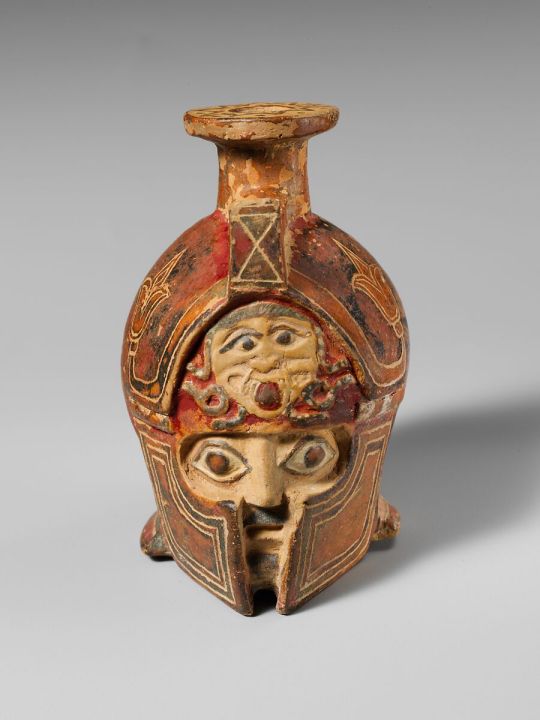#humanitarianhistory
Explore tagged Tumblr posts
Text

"Terracotta Aryballos (Perfume Vase) in the form of a sandaled right foot", Rhodian, Mid-Sixth Century BCE
Getting a Footing
I figured that for my first post I might as well address that yes, my icon is a foot. Well, it's not a foot in a "c'est n'est pas une pipe" kind of way. This beautiful object is a 6th-century BCE Aryballos, a specific type of Greek vase for holding oils, mostly perfumes, from the island of Rhodes. These vases come in all sorts of shapes and sizes, depicting scenes, animals, geometric patterns, or even, human figures.
The sandaled foot caught my attention the first time I ever visited the Met Museum. With my background being in Costume Design, my first immediate thought was "This is fantastic costume research". Very rarely do you get a three-dimensional depiction of clothing from ancient times in such considerably great shape. What I also found interesting is that this is not the only foot-shaped Aryballos in the Met's Collection, there was another, different in design, but also was an excellent depiction of Ancient Greek footwear. It reminded me of modern examples of foot-wear-shaped perfume bottles such as Carolina Herrera's Good Girl collection, pictured below, a parallel that greatly entertains me. Finding those commonalities with the ancients is one of the things I love most about archaeology and it poses the idea that maybe the ancient Greeks weren't unlike ourselves.
I was doing some reading on Ancient Greek perfumes in preparation for this post and came across an article by the Museum of Perfume Paris in which the author shares the story of Phaon, an old, ugly sailor, who was gifted a scented ointment by the goddess Aphrodite. This ointment when applied made Phaon young and beautiful, and any woman who saw him fell in love with him. Phaon's story is an interesting explanation of the romantic powers of perfume in Greek mythology, but it wasn't the only one. In the Illiad, song XIV, Helen applies perfume with the hopes of winning back her husband after the events of the Trojan War. It made me wonder if this Aryballos could have been a gift between lovers. Maybe as a way to remember their love or memorialize the beauty of their betrothed. Many Aryballos in the Met and others' collections are shaped like the helmeted heads of warriors, perhaps gifts for their loved ones as they went off to war.
It is important to note that perfumed oils were used by both men and women, and for a variety of occasions including religious ceremonies, weddings, funerals, and even athletic competitions. With that in mind, Aryballoi, in general, certainly uphold and project typical Ancient Greek values, such as class, gender, faith, and bravery, but I am curious as to the specific story behind the sandaled foot. Was it simply a display of socioeconomic status? Or perhaps it once stood as a reminder of love and admiration (The romantic in me likes to imagine so). I will leave you with these thoughts and I am interested to hear your own opinions.


Other Aryballoi in the Met's Collection. Left: Helmeted Soldier Aryballos, Right: Sandaled Foot Aryballos

Carolina Herrera's Good Girl Collection, Footwear Inspired Packaging
Read more about Greek Aryballoi and Ancient Perfumery below:
"Divine Scents in Ancient Greece" by Isabelle Bardiès, Musee du Parfum
"Perfumery from Myth to Antiquity" by Dimitra Voudouri & Christine Tesseromatis, International Journal of Medicine and Pharmacy
"The Greek Sense of Smell: Olfactory Perception and the Sociocultural Roles of Perfume in Antiquity" by Grainne Louise Grant, University of Exeter
#history#archeology#ancient greece#aryballos#perfume#ceramics#classical antiquity#greek history#ancient history#classical archaeology#greek mythology#humanitarianhistory
2 notes
·
View notes